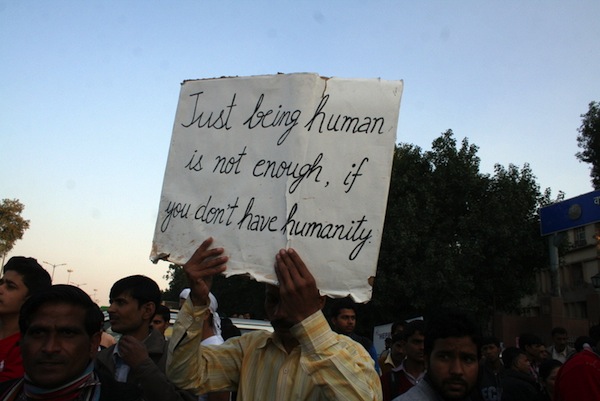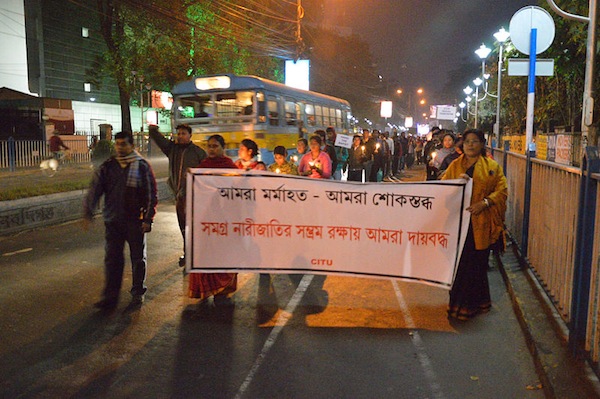

DELHI — In December, the brutal rape and subsequent death of a 23-year-old female student quickly gained attention in Indian and foreign media. In the days immediately following the woman’s death, protesters staged large demonstrations at Delhi’s India Gate and outside government buildings, including Rashtrapati Bhavan, the official residence of India’s President.
During the protests, activists and journalists used social media to follow the protests and to discuss India’s problem of violence against women. This discourse highlighted how social media offer an emerging space for storytelling — remarkable in a country where social media hasn’t had the same impact it has elsewhere. To explore this case, we interviewed Indian and foreign correspondents who covered the protests in Delhi. They told us how journalists used social media during the protests, giving us insight into how a new medium is contributing to hard news coverage.
Social media hasn’t played anything near the role in Indian journalism that it does in, say, the United States. Supporters of social media often point to their inclusive and democratizing aspects — but in India, social media usage remains confined to a small percentage of the population. Nearly 80 percent of Indians now have a mobile phone, but only 11 percent have Internet access, and fewer than 5 percent use social media. In rural areas, these percentages are significantly lower. Information gathered from social media tends to come from a rarified segment of the population: the affluent, educated, English-speaking youth of India’s major cities.
When we asked journalists to what extent they use social media for news-gathering, some complained that social media discussions are narrow. As an India-based journalist for the Swiss Neue Zürcher Zeitung told us:
They don’t really represent the majority of the people. For example, if you read social media, you would think everyone was extremely shocked and devastated. But if you talked to people on the streets or in slums, you get the idea that many Indians have extremely backward and conservative idea about women and how they had to behave. Social media can not replace doing research on the ground, in slums and villages. That’s the most important thing for working in India.
The digital divide thus represents a sociocultural divide: In India, those who use social media are more likely to live in cities, hold a passport, and share values with social media users in the West. By relying too heavily on social media, journalists may find that their coverage skews toward a narrow readership. One Australian journalist told us that the rape protests gained prominence on Twitter “because [social media] is city-based and at the center of the life of the middle class, university students, and mobile professionals.” The journalist from Neue Zürcher Zeitung told us “it is easy to share ideas and read articles of colleagues or see what intellectuals think.” What’s more difficult is to get beyond that narrow demographic and understand the views of Indians whose voices are not heard on social media.
According to Rohan Venkataramakrishnan, senior reporter at the Mail Today, social media presents a challenge for nuanced debate: “If I wanted to write about how Indian society needs to change or how patriarchy needs to be dealt with, I cannot say it in 140 characters.”
While journalists may have personal affinity with social media users, several of them told us that to get a more representative understanding of issues, they pay attention to television and newspapers. Here’s the journalist from Neue Zürcher Zeitung: “Television, newspapers, and talking to people on the streets were much more important [in newsgathering]. Only a very small part of society has access to social media, but everyone watches television.”

In addition to questions of representation, journalists have another reason to discount social media reporting. As we discussed in an earlier piece, India’s newspaper industry is thriving. With healthy growth in newspaper circulation and advertising, many journalists are skeptical about what social media can do for Indian journalism right now. When we conducted interviews with journalists at The Hindu, we encountered a widespread belief that social media is mostly for soft news. But that was before the Delhi gang rape and protests. The question now is: Will this event change the role of social media in Indian journalism?
In the past, television networks have been the largest players in Indian news coverage. Social media haven’t changed that, but have instead provided new avenues for news-gathering and story distribution. In the months preceding the events, Indian newspapers and television had covered a number of rape cases. But the December Delhi gang rape proved to be different. The brutality of the attack and the scale of the protests brought international attention to India’s problem of violence against women. Some journalists we spoke to highlighted the role of protest in democratizing India’s media.
The Delhi gang rape case prompted many journalists to use Twitter for updates on events and immediate responses from activists. To a greater extent than in previous protests, social media helped journalists keep a finger on the pulse of middle class India and get their immediate feedback on important issues. An Australian reporter said that “Twitter was really helpful to get a sense of the public sentiment and developments.” He followed the #delhigangrape hashtag, the official Twitter account of the Indian government, women’s groups, pressure groups, and Indian media on the subject.
Venkataramakrishnan, the journalist who found 140 characters limiting, nonetheless said that the protests have been incubators for social media sophistication in India. “Following the Anna Hazare case and the Delhi gang rape case, social media began to achieve a critical mass,” he told us.
Many journalists cited the importance of social media for background information. A journalist from The Hindu told us “I look at tweets by our own editor, editors from other newspapers, well known journalists such as Pritish Nandy [a columnist with The Times of India and the Hindi newspaper Dainik Bhaskar], Abhijit Majumder [editor of the Delhi edition of the Hindustan Times], and Saikat Dutta [a Delhi-based editor of the newspaper DNA]. I also look up tweets by television journalists such as Shiv Aroor [deputy editor at Headlines Today]. You get a mix of opinions from their tweets. Knowing these people’s perspectives helps me during coverage — but only indirectly…I rely on what I see when I am on the ground.”
Here we see the emergence of new storytelling beats. Many journalists and activists discussed how they used Twitter to stay informed about the locations of the protests. In this sense, social media has allowed for a new type of beat as well as a new element in storytelling. A foreign correspondent told us: “Last week, one of the accused rapists died in his prison cell, I found out about it on social media. I logged on Twitter, found students, and from there, the media picked up in India and our news organization called sources and confirmed.” Social media also helped journalists learn what coverage audiences wanted to read and see. Zoe Daniel, the Australian Broadcasting Corporation Southeast Asia correspondent, told us that in response to demand from members of India’s social media-savvy diaspora, she’s made plans for a documentary on the Delhi gang rape case.
A common theme with journalists we spoke to is that social media have enabled wider conversations with audiences. Ruchira Singh, social media editor at Network 18, told us that during the protests
Our editors and reporter were tweeting individually — we had very hectic social media activity during the case. We were inviting opinions on the goings on in the case; we were asking questions, we were asking people what they think are the solutions to the problems. We were interacting with people, asking them if they are joining a protest and how they are reaching the protest grounds. We promoted certain petitions by change.org. We asked people if they felt certain provisions should be incorporated in these petitions. I tweeted on the organizational account. I also tweeted on my individual account, especially when the girl died.
These interactions reveal new interest in social media by both Indian and foreign journalists covering the protests. In India, social media is a nascent enterprise still finding its place in journalism. But in time, we may see the the 2012 Delhi gang rape protests as a watershed moment for social media in news gathering and distribution. This case demonstrates how journalists respond to social media and how social media allows for new spaces for storytelling in India.
Social media has allowed a small but growing part of the Indian public to join in discussions of soft and hard news. To date, online storytelling has catered to certain demographic groups: the middle and upper classes, the intellectuals, activists, and journalists. Middle class discontent found a place on social media, but marginalized and subaltern groups had minimal representation or participation in social media discussions.
The Delhi gang rape case gives us insight into ongoing changes in India’s public sphere. Jürgen Habermas defined the public sphere as “a realm of social life in which something approaching public opinion can be formed.” But what kind of public sphere? Today, social media offer (at best) limited access to marginalized groups. Journalists who want to know about those groups cannot rely on social networking sites; they must visit often-remote towns, villages, and slums where most residents remain disconnected from social media. In the Delhi gang rape case and many other stories affecting India, social media is essential in research and reporting. At the same time, perhaps the greatest lesson is the limitation of social media: They offer starting points for news-gathering and distribution, but they haven’t replaced traditional journalism.
Smeeta Mishra is an assistant professor at the Centre for Culture, Media & Governance at Jamia Millia Islamia University in New Delhi. Her research interests include new media, research methods, Muslim studies, and gender issues.
Colin Agur is a Ph.D. candidate in communications at Columbia University’s Graduate School of Journalism and a visiting fellow at Yale Law School’s Information Society Project. He is interested in cultural and sociological aspects of mobile phone use in developing countries, and his dissertation research is based on ethnographic fieldwork in India.
Photos by Ramesh Lalwani and Biswarup Ganguly used under a Creative Commons license.